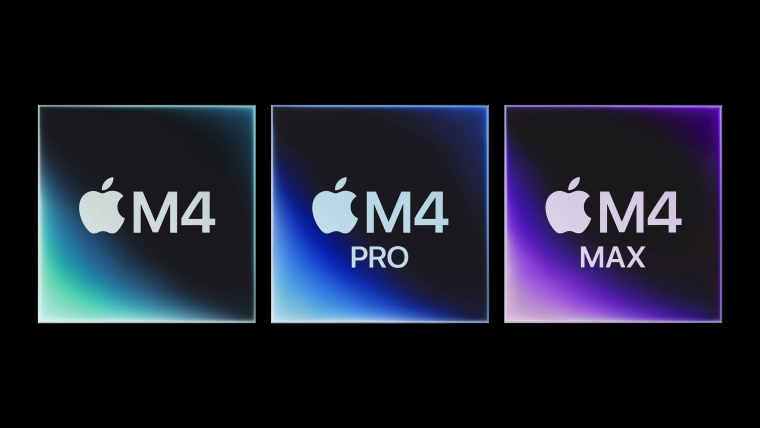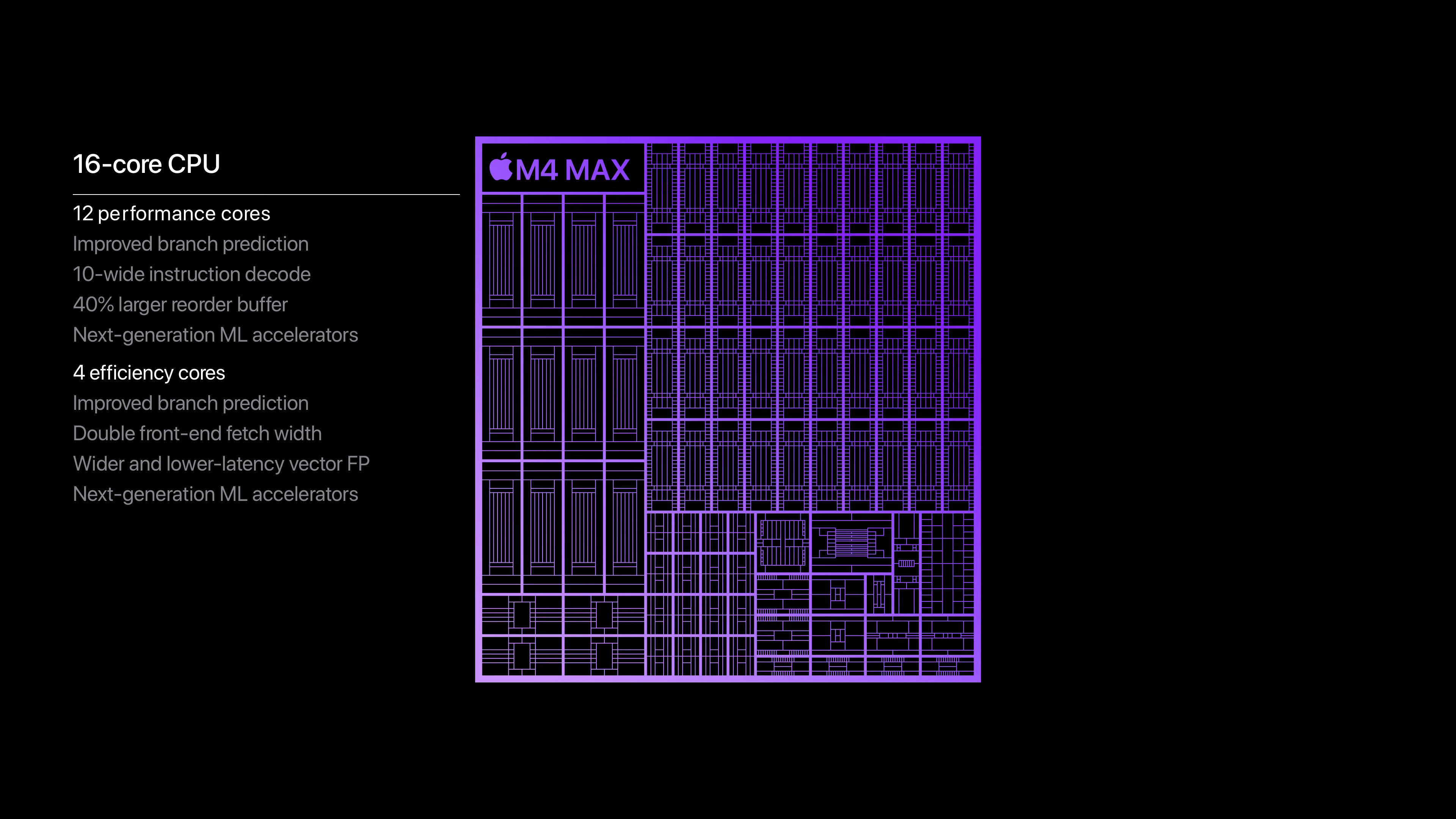
Apple-heavy news this week, and we have the rest of the M4 family chips launching, along with new MacBook Pros. To recap, the Apple Silicon M range is the company's own design for processors and graphics hardware that it migrated to a few years back after using Intel parts.
The M4 is a completely different kettle of silicon fish compared to Intel's x86 chips, but the long story short here is that Apple wanted fast performance yet low energy consumption for long battery life (the M4 MacBook Pros promise 24 hours) and cool-running devices. Intel wasn't able to deliver on that so Apple dropped them and rolled out their own chips.
By and large, that plan has worked out for Apple, with the Arm-architecture chips providing the annual speed bumps the company wants so here we are at the fourth iteration of the M range, made with a superfine 3 nanometre process by Taiwan's TSMC.

For its different product lines, Apple has segmented the M4 family in a similar fashion to the earlier range of Apple Silicon SoCs, and it can be quite complicated to keep them apart. Here's a table with the main feature differences.
| M4 | M4 Pro | M4 Max | |
|---|---|---|---|
| CPU Cores | 8-10 cores (3-4 performance, 4-6 efficiency) | 14 cores (8-10 performance, 4 efficiency) | 16 cores (10-12 performance, 4 efficiency) |
| GPU Cores | 8-10 cores | 16-20 cores | 32-40 cores |
| Unified Memory Configurations | 8, 16, 24 and 32 GB | 24, 48, and 64 GB | 36, 48, 64 and 128 GB |
| Memory Bandwidth | 120 GB/s | 273 GB/s | 546 GB/s |
| Neural Engine | 16-core, 38 TOPS | 16-core, 38 TOPS | 16-core, 38 TOPS |
| Thunderbolt Support | Up to 4 Thunderbolt 4 ports | Thunderbolt 5 (up to 120 Gb/s) | Thunderbolt 5 (up to 120 Gb/s) |
| External Display Support | Two external displays | Two external displays | Two external displays |
The base model M4 SoCs go into the refreshed iPad Pro, iMacs, Mac mini and MacBook Pro 14-inch. Meanwhile, the M4 Pro will be used for the top of the range Mac mini, and the MacBook Pro (as you can imagine), and the M4 Max is destined for the monster MacBook Pro Max.
Looking at the M4 Pro and M4 Max, the earlier M3 Pro variant came with 11-12 CPU cores and 14-18 GPU cores; the M3 Max, 14-16 CPU and 30-40 GPU cores. This is well-nerdy stuff but it indicates Apple is able extend the M range architecture with more cores for added performance.
The memory bandwidth has gone up too by quite a bit: from 153.6 gigabytes/s on the M3 Pro to 273 GB/s while the M4 Max is up to 546 GB/s from 409.6 GB/s. What that means is the processor and graphics cores can access data stored in memory much faster on the M4 chips than on the M3s - and of course, the earlier M1 and M2 models.
On the artificial intelligence side, Apple reckons that with 128 GB onboard, the M4 Max can handle large language models (LLMs) with up to 200 billion parameters. That's a pretty large LLM to run on your own computer, let alone a laptop.
The M3 Max with 96 GB handles Meta's Llama 3.1 with 80 billion parameters fairly well, although you notice it hits the limits of the machine with almost all memory being used up, Activity Monitor showing full usage of the GPU cores, fans starting up and battery disappearing noticeably fast.
Picking through the list of uprated specs, the Thunderbolt 5 peripheral ports look good for fast external storage, and the MacBook Pros have a HDMI port with 8K resolution now. But, no Wi-Fi 7 and only Wi-Fi 6E when the iPhone 16 has the newer standard?
The M4 system-on-a-chip (SoC) features other hardware accelerators as well, with a Media Engine that has two video encoders and two ProRes (Apple's video format for movie professionals).
How much are the new MacBook Pros then? The base 14-inch M4 model starts at $2999 including GST, for the 10/10 CPU/GPU model and it comes with 16 GB of memory, not 8 GB as in the past, and 512 GB of storage.
Six 14-inch MacBook Pro models launch today, along with four larger 16-inch screen ones. As per ancient geek tradition, ticking all the boxes on Apple's ordering site produces some impressive prices. Maxing out the 16-inch M4 Max MacBook Pro with:
- Nano-texture display to minimise glare
- 16/40 core CPU/GPU
- 128 GB of memory
- 8 TB storage
... sets you back by $13,309.00 including GST.
2 Comments
I do wonder quite what real uses (not AI) would require the spec indicated by a cutting edge $13309 laptop!
The only bigger price tag I've ever seen was a long time ago for a 20"(!) laptop that was a very, very special build for an Oracle staffer to allow independently simulating all sort of things involving their Big MRP and other systems. Damn thing was nearly a two hand lift: I suspect the Mac won't be.
You don't need to spend that much, but the M-series MBPs are pretty good for most heavy duty tasks like video/image editing, design, development and you could probably run a small cloud computing service on them for your friends if you felt like it. If you shoot movies for example, having the ability to process the footage on site fast means time and lots of money saved. The M4 Max MBP will do that while being portable.
In the scheme of things, it might not even be that the tick-all-options (which probably nobody would do) price is that much. This Dell Precision 7780 workstation laptop can be specced up to very impressive levels, and it doesn't take many clicks before you go past $20k.

We welcome your comments below. If you are not already registered, please register to comment
Remember we welcome robust, respectful and insightful debate. We don't welcome abusive or defamatory comments and will de-register those repeatedly making such comments. Our current comment policy is here.